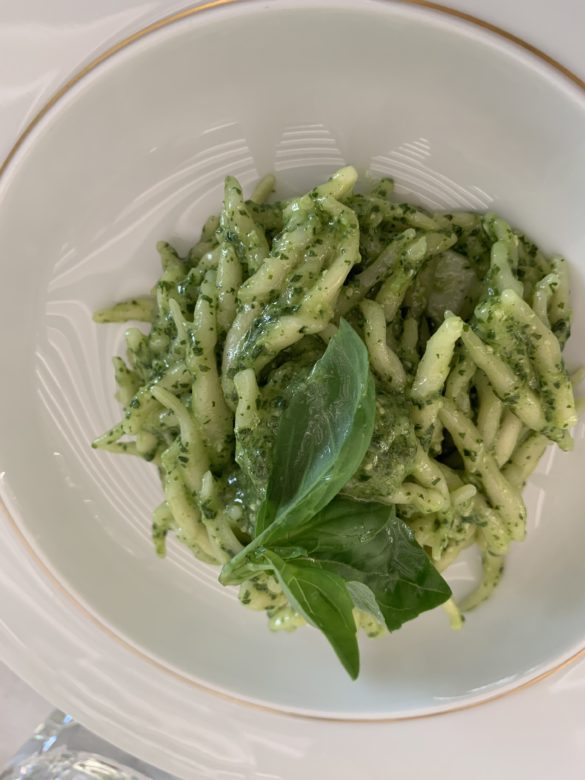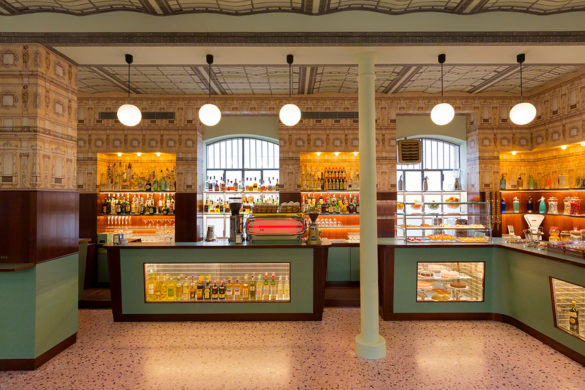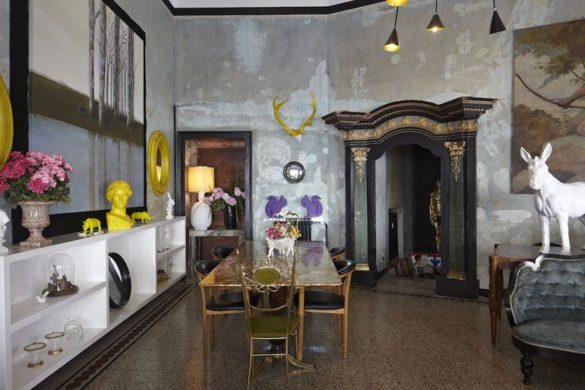While Milan may not be the first place that comes to mind when thinking about sublime culinary experiences in Italy—unlike, say, Bologna or Naples—the Milanese can be a picky bunch. And the population’s high standards have created a food scene that holds its own not just within Italy but globally, too, with buzzy restaurants and cafés regularly opening just in time for the city’s fashion weeks (like the Wes Anderson–designed Bar Luce in the brand-new Fondazione Prada). But it’s also the tried-and-true—the classics—that are often just as compelling (and aesthetically pleasing, if in a more traditional way). Read on for some favorites:
Da Giacomo (shown)
“This is the ultimate classic Milanese restaurant, with interiors by [Renzo] Mongiardino,” says Fellows, referring to the late Italian architect and interior designer. The room is meant to evoke the atmosphere of the early 20th century, with intricately embossed wallpaper and graniglia-tiled floors. Although the restaurant is known for its supremely fresh seafood, “I actually love the pizza with capers they serve even before the appetizers arrive,” Fellows says. Via Pasquale Sottocorno, angolo via Cellini, 6;
Carlo e Camilla in Segheria (Shown)
A relative newcomer to the Milan dining scene, the restaurant is striking “for its soaring, raw sawmill space,” Martin says, referring to its former industrial life. The atmosphere is almost reminiscent of a vast art gallery, and the food, such as a smoked sardine– and snail-filled tortellini entrée and salads mixed with edible flowers, is inventive. The elaborate—and beautifully made—cocktails are just as popular. Via Giuseppe Meda, 24; carloecamillainsegheria.it
Caffe Fernanda – Pinacoteca di Brera
Mix business and pleasure. The beautiful and the good. Art and food. In Milan, the combination of art and local cuisine is certainly nothing new, with successful openings of cafes and restaurants in famous museums that quickly gained equal importance, both serving as similar hubs of attraction and entertainment. Small but with a strong visual impact, the newcomer to the Milanese gastro-artistic scene is much more than a bar. Located on the first floor at the end of the museum route, where the old main entrance and, more recently, the bookshop originally stood, Caffè Fernanda looks like a luxury café, where the cozy and welcoming space is offset by the grandeur in design that reminds one of the refined 1950s era. Your attention is immediately caught by the chromatic choice with strong yet well-balanced color combinations, with pink velvet chairs, original marble floors (recovered by Piero Portaluppi), teal blue walls, and a large walnut and brass counter holding an immense painting by Pietro Damini. Caffè Fernanda goes beyond its typical function of serving breakfasts, light lunches and delicious aperitifs. It is an integral and welcomed part of the Pinacoteca.In addition to Damini’s painting “La conversione del Duca di Aquitania,” while sipping a negroni, you can also admire “The Three Graces” by Bertel Thorvaldsen and the bust of Fernanda Wittgens, from whom the restaurant takes its name. A Milanese visionary, Fernanda Wittgens was not only the first woman to run a museum in 1940s Italy, but also the reason why we can still admire Mantegna’s “Cristo Morto” or Raffaello’s “Lo Sposalizio della Vergine.” After the war and the bombings that devastated Milan and the museum itself, Wittgens was committed to the reconstruction and rennovation of the Pinacoteca, making it the cultural powerhouse that it is today. The Café pays homage to her by telling her story on the pages of the menu. (Charlotte Cogliari – Flawless)
The Small
JJ Martin loves the “cozy, homey style” of this charming restaurant, whose interiors bring to mind a vintage shop—an eclectic mix of colorful objets d’art, antique furniture, and Pop Art. The unique design is part of what draws Milan’s art and fashion crowds, but there’s also the food, including specialties such as tagliolini ai funghi porcini [mushroom pasta] and an incredible tiramisu. Via Paganini Niccolo 3, angolo Piazza Argentina; thesmall.it
A Santa Lucia (shown)
Just a five-minute walk from the boutiques that line the city’s most famous shopping street, via Montenapoleone, the picture-frame–lined restaurant is popular with well-heeled locals as a lunch stop, as well as in-the-know visitors. “This is a Milanese institution,” says Arbesser. “It’s a few steps from the Duomo but doesn’t feel touristy at all. It’s elegant and great for all things Milanese, like saffron risotto or fresh artichoke salad with Grana shavings.” Via San Pietro all’Orto, 3; asantalucia.it
Pasticceria Marchesi
This renowned 200-year old Milanese patisserie – now owned by Prada Group – opened its third outlet in the Galleria Vittorio Emanuele II, the grand Giuseppe Mengoni shopping arcade opposite the Duomo. Nibble on delectable chocolates and pralines while taking in your pistachio green surroundings. Pasticceriamarchesi.com.it
Cracco
Milan restaurant Cracco harks back to the city’s golden age, with lavish interiors that match the grandeur of its 19th-century surroundings. The eatery has opened in Milan’s Galleria Vittorio Emanuele II – a glass-roofed shopping centre dating back to 1877 that was once known as the ‘parlour’ of the city. Still an important architectural landmark, the arcade attracts more than 100,000 visitors every day. Galleria Vittorio Emanuele II, Corso Vittorio Emanuele II, 20121 Milano Cracco
Aimo & Nadia
A convivial space in which the personalities of Stefania Moroni, Alessandro Negrini and Fabio Pisani, owners of Il Luogo di Aimo e Nadia, and of Rossana Orlandi, express themselves in a complementary way, each one in its own sphere, to give life, together, to a bistro which combines the charm of interior design, created in collaboration with Etro, with the pleasures of taste and conviviality, fundamental elements of the gastronomic proposal and service.Aimo& Nadia
Papermoon The secret to Paper Moon’s enduring success is certainly connected to the history of this first restaurant in via Bagutta, opened in 1977 by Pio Galligani with his wife Enrica del Rosso and still a primary choice of all those who embrace life and its pleasures.they are the right combination of warm modern design, the traditional recipes with a hint of innovation. The fettuccine ai fungi porcini is my favorite! papermoon.com
Drogherie Milanesi : Great and informal spot. Drogerie Milanesi

























